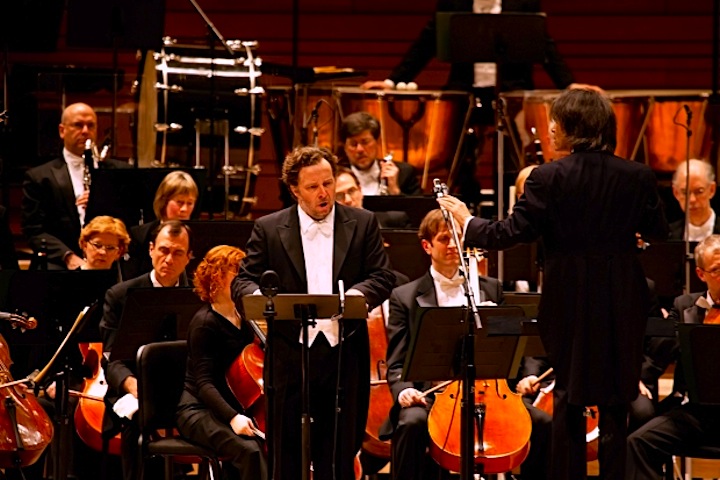
Symphony administrators may have a lesson or two to learn about artistic branding from the Montreal Symphony Orchestra, while music fans can sit back, eyes blissfully closed in anticipation, to savour the latest recorded fruits of this wonderful ensemble: orchestral songs by Gustav Mahler with German baritone Christian Gerhaher.
- Classical Music 101: What Does A Conductor Do? - June 17, 2019
- Classical Music 101 | What Does Period Instrument Mean? - May 6, 2019
- CLASSICAL MUSIC 101 | What Does It Mean To Be In Tune? - April 23, 2019
 Released by Quebec label Analekta, this has become my favourite album of the year, so far.
Released by Quebec label Analekta, this has become my favourite album of the year, so far.
The programme on this album — three cycles: Lieder eines Fahrenden gesellen (Songs of a Wayfarer), Kindertotenlieder (Songs on the death of Children) and Rückert Lieder — covers a bit more than a quarter of Mahler’s art songs.
Mahler, who spent a substantial part of his adulthood conducting opera, never wrote his own opera. Instead he wrote symphonies and even art song with a scope that threatened to blow apart the traditional forms.
Mahler’s art songs are not songs but fully staged mini plays, where the scenery is a hologram generated by gently undulating strings, and where the lighting brightens and dims as the woodwinds come and go. The main character is a poet, straining to express in a few words the seaweed-choked Sargasso Sea of human emotion.
Dare we enter that place ourselves, for fear of somehow not finding the right current to get us back out into the daily getting on with life?
The singer has to let herself go — but not too much. This music is hard to sing, but needs to emerge with utter clarity. How much does he chew some consonants for extra pathos — at the expense of a musical phrase — versus allowing the orchestra to do the emotional underlining for him?
Mahler’s orchestral textures are as clearly delineated as the facets on cut crystal. The conductor is the one who shines the right amount of light through the material to cause a rainbow to appear in the listener’s imagination.
German baritone Christian Gerhaher sings these 14 Lieder as if they were written for him — both vocally and temperamentally. The interpretations are fully evocative yet remain untouched by melodrama. And his voice is a wonder of flexibility and subtle colouring.
“Die zwei blauen Augen von meinem Schatz” (The Two Blue Eyes of My Beloved, from the Songs of a Wayfarer) is miraculous in its overall pacing. My other favourite is the album’s last: Ich bin der Welt abhanden gekommen (I Have Let Go of the World), another bit of poetry by Friedrich Rückert (1788-1866) on no longer wanting to be a part of this harsh world, where Gerhaher again achieves remarkable emotional communication with a minimum of means.
The other hero on this album is Montreal Symphony music director Kent Nagano, who brings the sort of precision and discipline to the orchestra that I’m sure would have made the cantakerous and obsessively perfectionistic Mahler weep for joy.
Even if you think of yourself as Mahler-averse, relent for a minute or two and give one of these songs a try. You may find a whole new world of music-as-emotion opened to your ears.
You can find all of the album details here.
+++
In all of this artistic excellence lies a lesson in orchestral branding.
Thanks to Franco-Swiss music director Charles Dutoit, the Montreal Symphony Orchestra became one of the world’s go-to large ensembles for 19th and 20th century French music in the last two decades of the 20th century.
It wasn’t that these musicians were somehow predisposed to playing this repertoire better than others; they had an iron-willed conductor who liked this repertoire, and moulded the sound in a way that agreed with listeners.
Current music director Kent Nagano has driven the orchestra eastward into the Germanic lands, with nearly the same sort of critically loved results. Montreal as a seat of Teutonic expression? Why not? It’s about the conductor being able to clearly communicate what they want, not about where the players come from.
Where Dutoit was hot, Nagano is cold. Where Dutoit charged the ensemble with controlled explosions, Nagano is deeply analytical.
I have to state my prejudice that I am not attuned to Nagano’s musical vision most of the time, but I have to bow low and long to the beauty of this recording, made at the Maison symphonique in January, 2012.
The successful shift from French to Austro-German repertoire at the other end of the 401 has made me wonder about the Toronto Symphony Orchestra and its own recording programme, which has failed to capture the attention of people outside the organization’s existing base.
The orchestra’s playing is beautiful, if not always done justice by having it recorded at Roy Thomson Hall (the TSO’s best-loved album from the past, the great Andrew Davis Messiah with Kathleen Battle, was recorded in Kitchener — only the album cover image was taken at Roy Thomson Hall).
Instead of having a contract with a prestigious old-school label, the TSO has been releasing new recordings on its own (through tsoLive), but that’s the case with many great orchestras around the world now.
I suspect the problem lies within the artistic vision of the orchestra, not an outside factor.
Music director Peter Oundjian has fundamentally refashioned the orchestra with new principal players. The strings now sound fantastic. The brass and woodwinds, long bullwarks of strength, are as good as ever. But what is this orchestra all about?
My guess is that Oundjian and the TSO are trying to be eclectic and flexible, representing the tastes of as many classical music fans as possible. But is that the way for an orchestra to survive in the 21st century?
It’s a question I’ve been wishing (but not given the opportunity) to ask Oundjian for the past couple of months, as we enter the final four years of his time in Toronto (it is highly unlikely that his contract will be extended beyond 2017) — a time when any music director would be intent on putting the crowning touches on their legacy.
John Terauds
- Classical Music 101: What Does A Conductor Do? - June 17, 2019
- Classical Music 101 | What Does Period Instrument Mean? - May 6, 2019
- CLASSICAL MUSIC 101 | What Does It Mean To Be In Tune? - April 23, 2019



